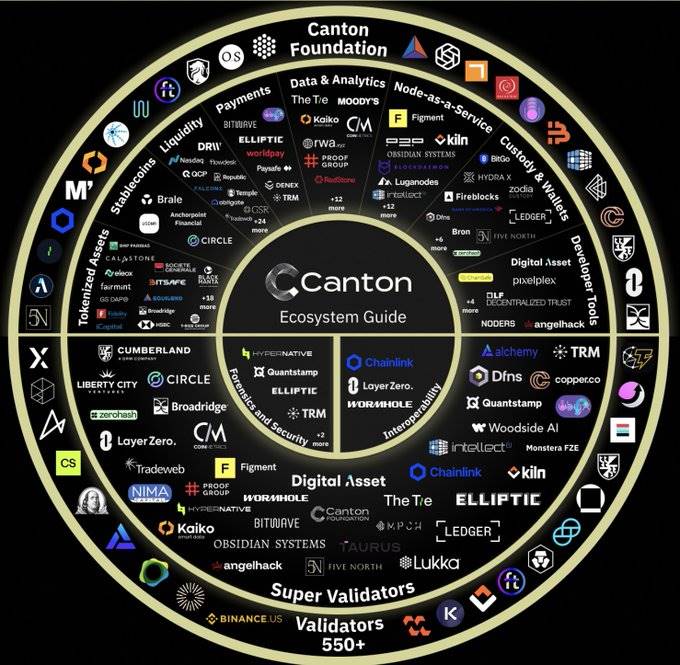The issuance of Canton Coin (CC) has no hard cap, but every transaction will burn CC, offsetting the newly issued amount.
Author: Canton Network

Many people see the issuance curve of Canton Coin (CC) and often think its maximum supply is fixed at 10 billion coins. However, this is a misconception, and this article will explain this issue in detail.
Dynamic Supply, Not a Fixed Cap
The supply mechanism of Canton Coin (CC) is very similar to Ethereum's ETH or Solana's SOL: theoretically infinite, but practically quite stable.
Canton Coin (CC) has no hard cap on its issuance, but every transaction will burn CC, offsetting the newly issued amount. Over time, the forces of issuance and burning will reach a balance around network activity and market price.
This means that as the burn rate increases with usage, the total supply will stabilize at a level far below the theoretical issuance curve.
FDV and Market Cap
For Canton Coin, FDV and market cap are essentially the same:
FDV = Market Cap = Current Total Supply × Current Market Price
Future supply depends on the ratio between the amount burned and the amount issued, which is determined by network demand.
In the short term, the inflation rate of CC will be higher than that of Ethereum or Solana, but as the issuance rate halves and the amount burned increases, the inflation rate will steadily decline.
How Supply Adjusts
Canton fees are priced in USD (per MB of transaction data), but are paid through the burning of CC tokens at the on-chain exchange rate.
When network demand is high (i.e., the price of CC is relatively low compared to usage), the number of CC tokens burned increases, slowing the growth of supply, or even leading to deflation.
When network activity is low, the burn rate slows down, and supply increases.
This dynamic mechanism creates a natural burn-issue equilibrium (BME), which is a feedback loop between usage, price, and supply.
Long-term Equilibrium
Once the market reaches equilibrium under the BME, the issuance and burning amounts should be roughly balanced.
At that time, the total supply should remain relatively stable and adjust slowly based on long-term demand.
Since the supply will adjust dynamically, market cap (rather than the theoretical maximum supply) is the correct way to measure value.
Example Illustration
Scenario: The network reaches equilibrium between validators and application pools.
Assumption: All tokens allocated to validators and applications will be burned in one block.
Super Validators (SV) rewards are the only source of inflation.
So, if equilibrium is reached by mid-2026, the total supply may look as follows:
Projected Total Supply
July 2026: 4.2 billion CC
July 2029: 4.8 billion CC
July 2034: 5 billion CC
These estimates may be on the high side. Over 1 billion CC tokens have already been burned, and the network burns approximately $900,000 worth of CC tokens daily.
In this case, if SV is the only source of issuance, the annual inflation rate would be about 32.5 million CC, or less than 0.1% based on 4 billion CC.
Key Issuance Milestones
The most important upcoming event in the dynamic supply of Canton tokens is the halving on January 1, 2026, which will lead to a double halving of the number of tokens for Super Validators (SV).
First, the total issuance per block will be halved.
Second, as more rewards will be allocated to validators and applications, the share of SV in that issuance will drop from 48% to 20%.
Three years later, a similar "double halving" will occur again:
The total issuance will be halved again, and SV's share will drop from 20% to 10%.
This compounding effect means that once the network reaches a burn-mint equilibrium (BME) between validators and applications, the SV pool will become the primary and rapidly shrinking source of new issuance.
By the early 2030s, the issuance from SV will account for only a small portion of the total supply, making the inflation rate of Canton Coin one of the lowest among mainstream Layer 1 networks.
Conclusion
Like any resilient network, value increases with utility. Through the fee consumption mechanism, each transaction promotes the scarcity and consistency of resources. The Canton ecosystem vividly demonstrates this dynamic process.

免责声明:本文章仅代表作者个人观点,不代表本平台的立场和观点。本文章仅供信息分享,不构成对任何人的任何投资建议。用户与作者之间的任何争议,与本平台无关。如网页中刊载的文章或图片涉及侵权,请提供相关的权利证明和身份证明发送邮件到support@aicoin.com,本平台相关工作人员将会进行核查。




